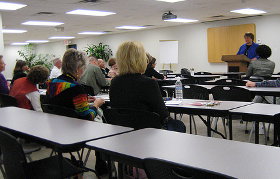 It’s very easy to say, but teaching adults is very different from teaching children.
It’s very easy to say, but teaching adults is very different from teaching children.
However, sometimes it is difficult to put this truism into practice. It requires a change of mindset and frequently teachers themselves have only been taught the skills required to teach kids.
Tip 1: Comfortable Classrooms
Adults, even more than children, need to be in an environment that is conducive to learning. That means good lighting, good line of sight for all students to the whiteboard or teacher and appropriate use of technology. Even comfortable chairs will make a difference.
I appreciate that some of these things may be beyond the control of the teacher but they do make a big difference.
Tip 2: Relevance And Practical Application
Keep in mind that, in the vast majority of cases, your adult students have chosen to be there. This means that you should explain why each thing you are teaching is useful. You need to explain it’s relevance and how they might be able to apply it in practical situations, either personally or professionally.
Tip 3: Respect And Learn From Your Students
Keep in mind at all times that these are adults. They have life experience, knowledge and skills that you yourself may not have. If you can incorporate these into class discussion and into the course work itself you will be able to bring out the best in your students. Better yet, you may just learn a thing or two yourself.
Tip 4: People Learn In Different Ways
While this is also true of children, you should be aware that adults have very different ways of absorbing and retaining information.
Your lessons should include visual, kinesthetic and auditory elements to make sure all types of learners are included. Handouts, and graphs, in-depth classroom discussions and role-playing should all form a part of your lesson planning in order to achieve this. Basically, you need to get adult students involved in the process of learning on as many levels as you can.
Tip 5: Stay Well Back…And Don’t Patronize
One of the most frequently cited problems teachers who have transitioned from teaching children mention is that their attempts to ‘help’ their adult students are often met with resentment.
Once again, remember that you are dealing with adults here – capable, often professional people who in their day to day lives are unused to being ‘taught’.
Allow students to work at their own pace and resist the temptation to jump in as soon as you see someone making a mistake. You’ll find that most students will come to you if they need assistance and that you will learn to identify the right opportunities to offer guidance if they don’t.
Jumping in too quickly with offers to explain where someone is going wrong can often be misinterpreted as being patronizing, which is the last thing you want.
Adults – unlike children – are perfectly able to take responsibility for their own learning.
Once you have taken these tips on board, you will find – if you haven’t already – that teaching adults can be even more rewarding than educating the young. Better yet, you will certainly learn a few things yourself along the way.
